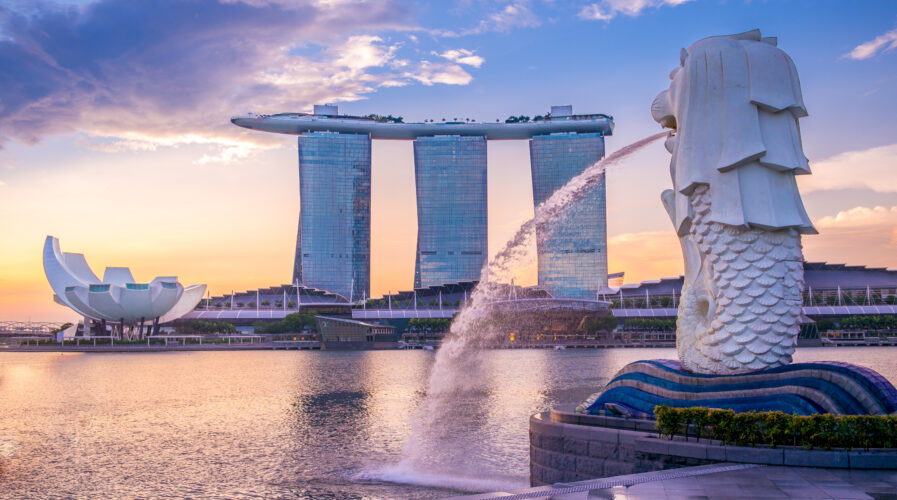
(Source – Shutterstock)
A new era of data centres in Singapore
Around the world, individuals and corporations are working to reduce their carbon footprints. In Southeast Asia, Singapore and other ASEAN countries are no exception as well. More initiatives are being made to enable greener and sustainable data centres.
The International Energy Agency reports that data centres consume approximately 200 terawatt-hours (TWh) of electricity or nearly 1% of global electricity demand. This contributes to 0.3% of global carbon dioxide emissions.
At the same time, as data continues to grow exponentially and the need for faster and more powerful computing needs increases, these figures are expected to rise in the future as well, without proactive steps to reduce data centre energy consumption.
In Singapore, the government aims to halve carbon emissions by 2050 – a challenging goal when it comes to the selection of data centre investments, due to them being big consumers of electricity.
With the region projected to be the fastest-growing region in the world for data centres, Singapore remains an attractive data centre hub. What this means for Singapore’s commitment to its environmental goals, is a stricter set of standards when it comes to the selection of data centre investments.
Tech Wire Asia speaks to Andy Ng, Vice President and Managing Director for Asia South and Pacific Region at Veritas Technologies to get his views on what data centres can do to become more sustainable and reduce their carbon emissions as well as the new regulations to set up data centres in Singapore.
Why data centres can have detrimental effects on the environment?

Andy Ng, Vice President and Managing Director for Asia South and Pacific Region at Veritas Technologies
Data centres are dedicated facilities that house vast arrays of computing infrastructure, storage and networking systems. We can see data centres as physical places to store, process, compute and share data that are necessary to the continuous operations of organisations.
Data centres consume a lot of space – the largest data centre in the world sprawls across the land size of 22 football fields. In Singapore where land is scarce, data centres are housed in multi-storey buildings. Data centres run 24/7 in a temperature-controlled environment. In addition to IT equipment, data centres also require facilities infrastructures such as power subsystems, uninterruptable power supplies, ventilation and cooling systems and backup generators.
While data centres form the backbone of a booming digital economy, they are also huge energy hogs. Everything from the servers, storage equipment and cooling infrastructures has a large appetite for electricity and water. For instance, cooling alone can consume up to 40% of a data centre’s energy consumption. This, in turn, will have an undeniable negative impact on the environment.
Estimates suggest that data centres are responsible for up to 5% of global greenhouse gas emissions. In Singapore, data centres accounted for 7% of the country’s electricity consumption. Clearly, as indirect greenhouse-gas emitters through electricity use, data centres contribute to global warming and put a considerable strain on the environment.
What are the new standards for data centres in Singapore, and what does it mean for any players who wish to enter Singapore, considering its status as a major data centre hub in SEA?
Singapore is setting very stringent efficiency guidelines for new data centres in the country. When the moratorium lifts in Q2 2022, only three applications will be approved during the pilot phase for data centre capacities of between 10MW and 30MW. Additionally, the new data centres are required to have a power usage effectiveness (PUE) OF 1.3 and below and demonstrate their quest for innovation and sustainability solutions.
The new standards will reinforce the need for players to make it a business imperative to design and implement energy-efficient solutions, spanning from improving the efficiency of powering and cooling data centres, to improve the efficiency of IT systems. For example, the new entrants can consider implementing the right tools and protocols that can autonomously self-provision, self-optimise, and self-heal data management services to keep data safe and available.
Will the new standards in Singapore affect other data centres in the region?
Singapore remains an attractive location for data centres and is ranked second among data centre markets globally. With climate action gaining pace internationally, developing a sustainable, energy-efficient data centre sector is important to combat the burgeoning environmental cost of carbon footprint.
By mandating new efficiency standards, Singapore can tap into the new opportunities presented by the green transition. This could set the stage for Singapore to become a leader in best-in-class techniques, technologies, and practices for energy efficiency and decarbonisation, to secure a more sustainable future for ourselves and the region.
What is the outlook on data centres in Singapore, as well as SEA, considering the conscious need to go green also contributes to lower energy costs, arguably one of the highest costs for a data centre?
Rapid digitalisation continues to fuel the growth of data centres. The growth in digital apps, e-commerce, IoT, artificial intelligence and online collaborative tools such as video conferencing are key reasons why data centres remain essential and highly lucrative.
With its solid infrastructure high-speed connectivity and minimum risks of natural disasters, Singapore is poised to build on its competitive advantages to capture the green opportunities. The entire region is also expected to benefit from digitalisation and new technologies, with a recent report predicting a CAGR of over 6% for the data centre market in Southeast Asia for the period between 2019 and 2025.
With the need for workers comfortable in both hardware and software, would the talent pool be sufficient to staff and support the data centre industry, both in Singapore and in the SEA region?
There is no question that the world is facing an IT talent crunch. With the exponential growth of data and data centres, demand for talent in areas such as cloud architecture, artificial intelligence, cybersecurity, and electrical engineering will only escalate. With the growth of hybrid cloud environments, IT staff will need to deepen their expertise and keep up with the evolving landscape to secure and protect cloud computing resources and ensure connectivity between data centres and the cloud providers.
In the global war for talent, the industry will have to find ways to fill the gap. These include strategies such as recruiting a more diverse and inclusive workforce by attracting more women to the tech industry or being open to those without a technical degree; investing in training and in-house talent development, or even partnering with universities and vocational and technical colleges to attract new graduates who often gravitate towards big brand names. From the technology perspective, data centre players can consider adopting modern autonomous data management tools that harness artificial intelligence and machine learning to reduce the need for so many IT staff.
READ MORE
- Ethical AI: The renewed importance of safeguarding data and customer privacy in Generative AI applications
- How Japan balances AI-driven opportunities with cybersecurity needs
- Deploying SASE: Benchmarking your approach
- Insurance everywhere all at once: the digital transformation of the APAC insurance industry
- Google parent Alphabet eyes HubSpot: A potential acquisition shaping the future of CRM


